Exercises (1800)
Raising and lowering one arm and leg crosswise in supine position alternating (bringing hand and foot together) ► single leg jack knife / alternating leg v-up
Power
Individual work
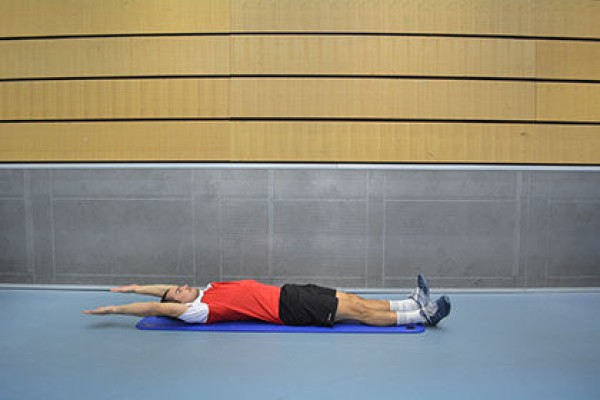
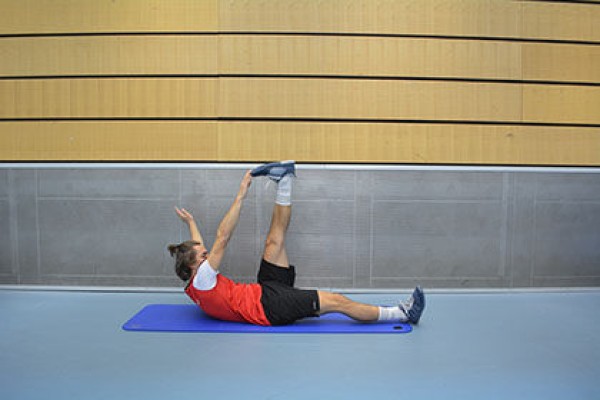
Lie on your back with your arms stretched out in extension of your body, arms and legs flat on the floor, alternately raise one arm and one leg crosswise and bring them together (hand to foot/shin), lower the limbs and perform the movement with the other arm or leg.
Lighten:
Lift the arm and leg less (without bringing the limbs together).
Harden:
Additional weight for the arms/legs; do not fully lower the limbs.
2-4 weight cuffs/2 weight balls/dumbbells ► Make the exercise more difficult (additional weight)
Raising and lowering one arm and leg crosswise in supine position alternating (bringing hand and foot together) ► single leg jack knife / alternating leg v-up
Power
Individual work
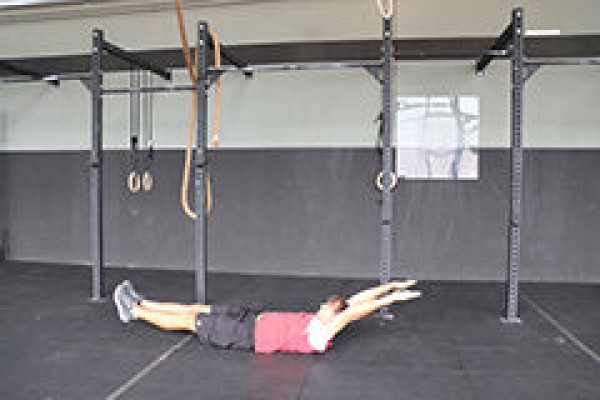
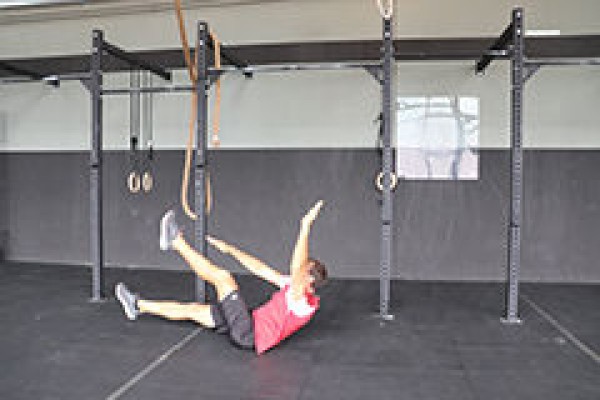
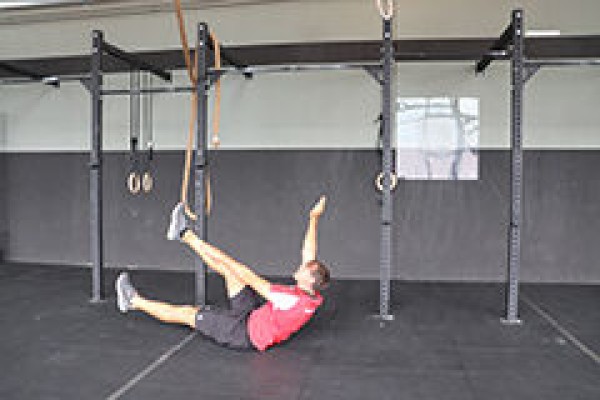
Lie on your back, arms and legs stretched out in extension of the body and slightly raised, raise one arm and one leg crosswise so that the hand touches the tip of the foot (or at least the shin) (raise arm and leg simultaneously). Switch sides for the next exercise.
Attention:
Do not lower your legs and arms (constant tension).
Lighten:
Lower your arms and legs completely after each exercise (pause); raise your arm and leg less.
Harden:
Additional weight (for the arms and/or legs).
Variation:
Lift both arms up and move the hands towards the raised foot/shin.
2-4 weight cuffs/2 weight balls/weight discs/dumbbells ► Make the exercise more difficult (additional weight)
Raising and lowering one arm and leg crosswise in supine position alternating (bringing hand and foot together) ► single leg jack knife / alternating leg v-up
Power
Individual work
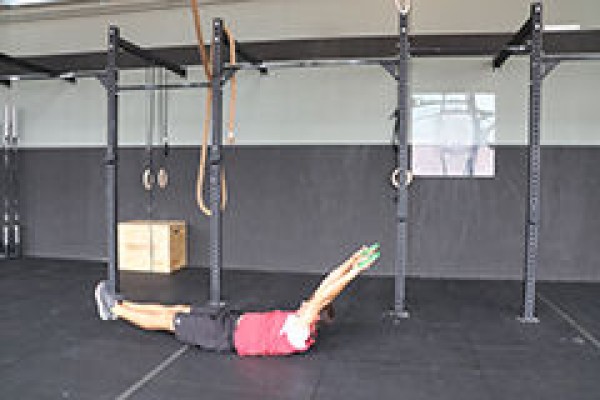
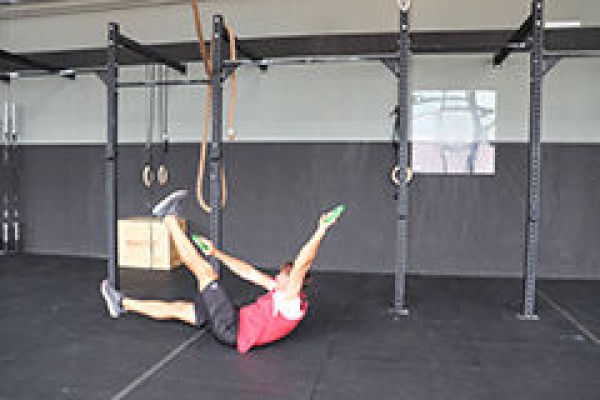
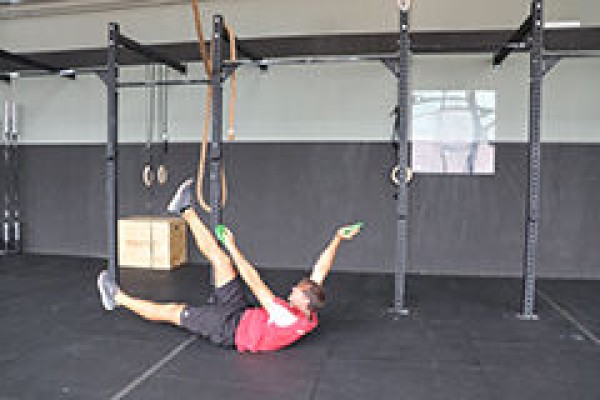
Lie on your back, arms and legs stretched out in extension of the body and slightly raised, holding a light dumbbell, small weight disc or weight ball in each hand, raise one arm and one leg crosswise so that the weight is brought to the tip of the foot (or at least to the shin) (move arm and leg upwards at the same time). Switch sides for the next exercise.
Attention:
Do not lower your legs and arms (constant tension).
Lighten:
Lower your arms and legs completely after each exercise (pause); raise your arm and leg less.
Harden:
Additional weight (for the arms and/or legs); more weight.
Variant:
Lift both arms up at the same time and move your hands towards the raised foot/shin.
2 dumbbells (light)/weight discs/weight balls
2-4 weight cuffs ► Make the exercise more difficult (additional weight)
Raising and lowering an arm and leg crosswise in supine position alternating (bring hand and foot together) ► alternating leg raise / alternating leg v-up
Power
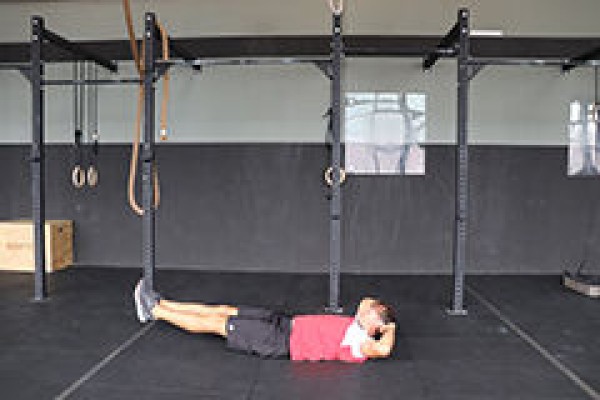
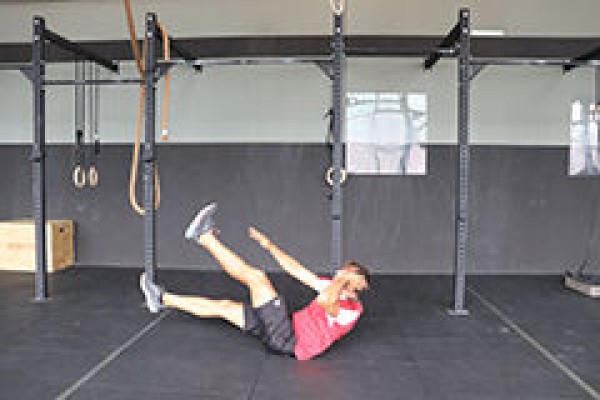
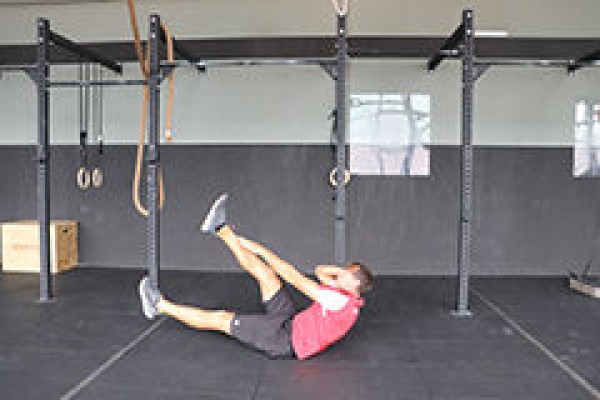
Lie on your back with your arms bent behind your head (elbows pointing to the side). Raise one leg and at the same time bring the respective arm crosswise to the instep of the foot (or at least to the shin). Lower your free leg again, bring your arm behind your head and switch sides for the next exercise.
Attention:
Keep your (lower) back in contact with the floor (no hollow back, consciously tense your abdomen)
Lighten:
Lift your arm and leg less (do not bring your limbs together).
Harden:
Never put your legs down completely; add weight (for the arms and/or legs).
Variant:
Lift both arms upwards and move your hands towards the raised foot/shin.
2-4 weight cuffs/2 weight balls/weight discs/dumbbells ► Make the exercise more difficult (additional weight)
Alternating raising and lowering of one leg in forearm support
Power
Individual work
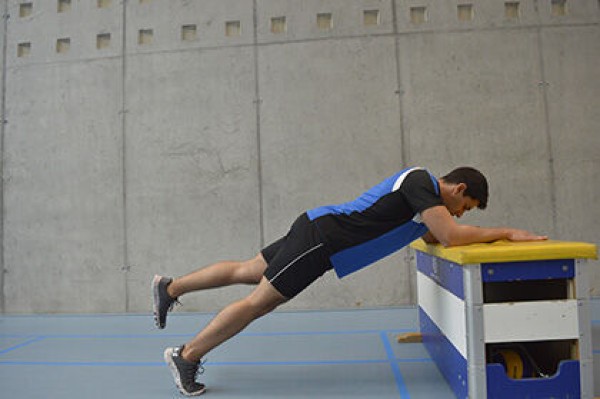
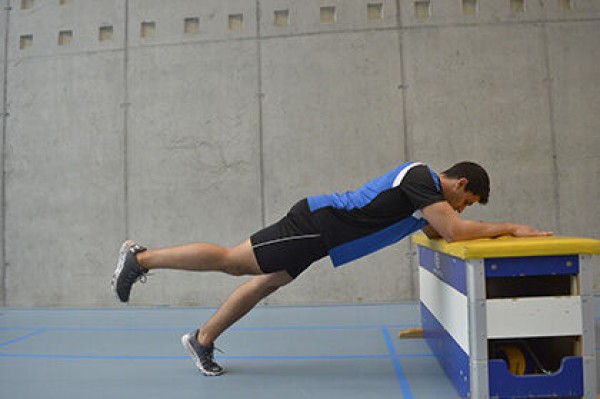
Underarm support on the top of the Swedish box, legs stretched (toes on the floor), alternately lift one leg slightly.
Attention:
No hollow back, head in extension of the spine, shoulders remain above the elbows.
Lighten:
Support in place (without lifting and lowering the legs), more box elements (more upright position).
Harden:
Just hold the position, but with an unstable base for the legs; fewer box elements (more lying position).
2-3 swing box elements (incl. upper part)
1 ball/1-2 balance cushions/1 balance board ► Make the exercise more difficult (unstable base)
Alternating raising and lowering of one leg in forearm support
Power
Individual work

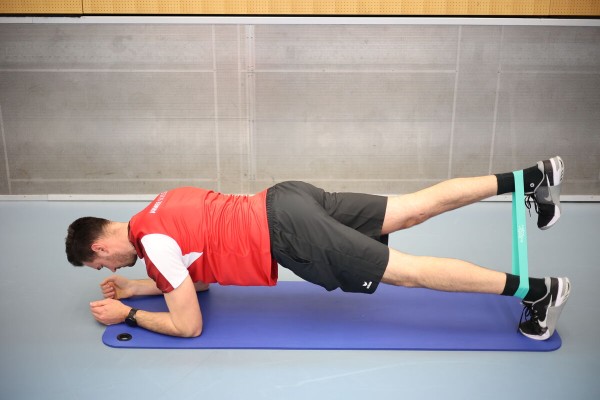
In the forearm plank, the outstretched legs and upper body practically form a line. The legs are supported on the tips of the toes and the upper body on the forearms. The forearms lie flat and parallel to each other with the upper arms resting vertically on the floor (90 degree angle at the elbow joint). Stretch an elasticated band between your legs (place the band around your ankles) and alternately raise and lower one leg (alternating hip extension).
Attention:
Head, torso, hips and knees form a line (do not stretch your buttocks upwards or allow them to sag, tense your stomach). The hands should not touch/be locked.
Lighten:
Choose a rubber band with less resistance.
Harden:
Choose a rubber band with greater resistance; additional weight (on the legs and/or back); unstable support for the arms.
Variant:
In a push-up position (instead of forearm support).
1 mini band
2 weight cuffs/1 weight vest/weight disc/sandbag ► to make the exercise more difficult (additional weight)
1 balance cushion/balance board ► to make the exercise more difficult (unstable base)
Raising and lowering one leg in forearm support alternately ► marching pillar bridge / plank leg lift / plank leg raise
Power
Individual work
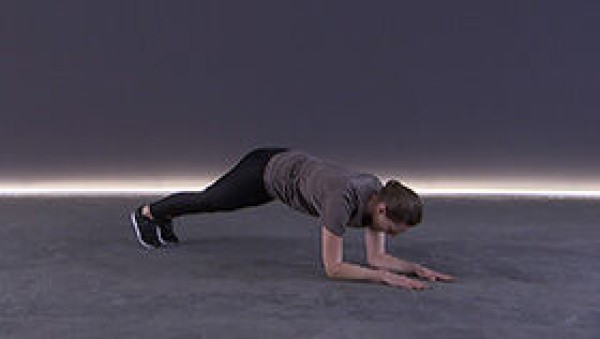
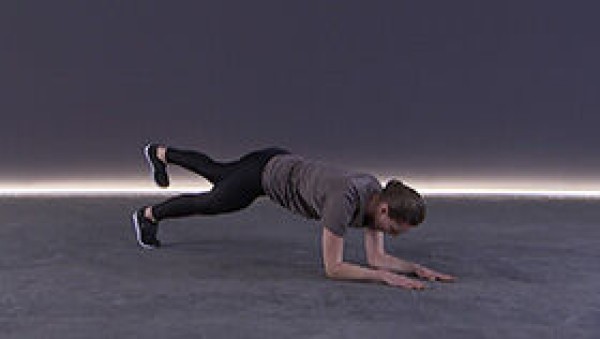
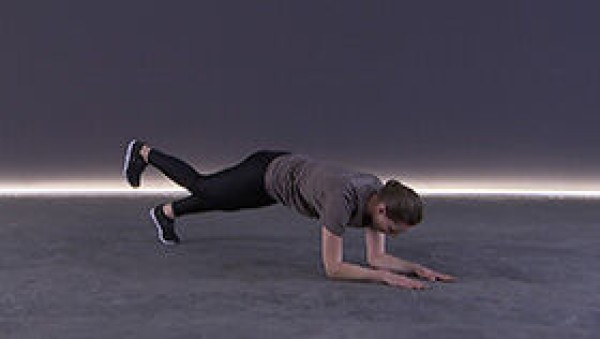
In the forearm support, the outstretched legs and upper body practically form a line. The legs are supported on the tips of the toes and the upper body on the forearms. The forearms lie flat and parallel to each other with the upper arms resting vertically on the floor (90 degree angle at the elbow joint). Alternately, raise one leg slightly (foot approximately at heel height).
Attention:
Head, torso, hips and knees form practically a line (do not stretch your buttocks upwards or let them sag, tense your stomach). The hands should not touch/be closed.
Lighten:
Knees on the floor (feet held high); only hold the position (without lifting the legs).
Harden:
Additional weight (on the back); unstable support (for the arms).
1 weight vest/weight disc/sandbag ► to make the exercise more difficult (additional weight)
1 ball/balance cushion/balance board ► to make the exercise more difficult (unstable surface)
Raising and lowering one leg in forearm support alternating backwards ► marching reverse pillar bridge
Power
Individual work
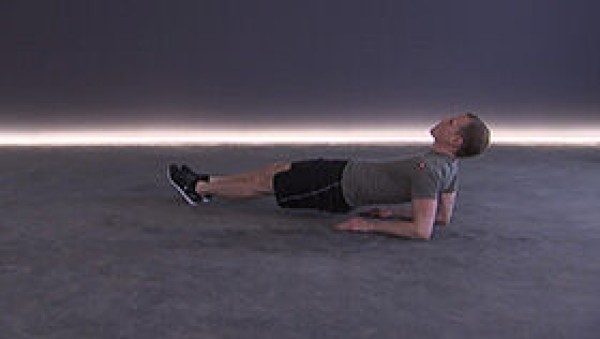

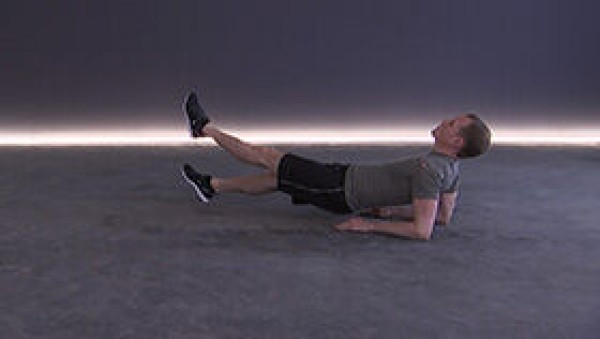
Inverted forearm support (the outstretched legs and upper body practically form a line, the legs are supported on the heels and the upper body on the forearms, the face/gaze thus points upwards, the forearms lie flat on the floor parallel to each other, the upper arms are vertical), alternately raise one leg outstretched (approximately at the height of the tip of the foot) and lower it again.
Attention:
Head, torso, hips and knees practically form a line (do not let your buttocks sag, tighten your stomach), do not hyperextend your knee joints.
Lighten:
Bend your legs slightly.
Harden:
Additional weight (on the hips); unstable base for the legs (arms probably too heavy).
1 weight vest/weight disc/sandbag ► to make the exercise more difficult (additional weight)
1 ball/balance cushion/balance board ► to make the exercise more difficult (unstable surface)
Raising and lowering one leg in forearm support alternating backwards ► marching reverse pillar bridge
Power
Individual work
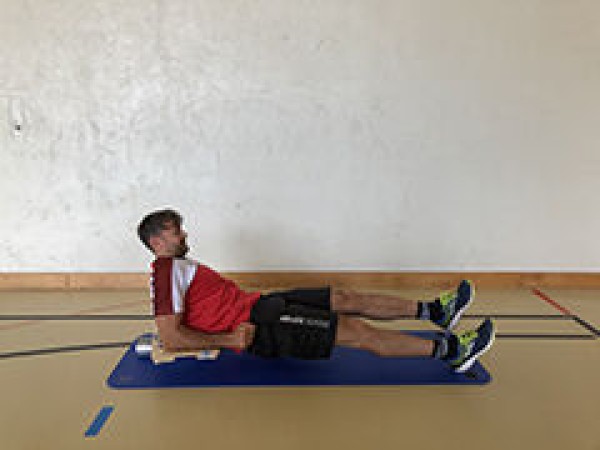

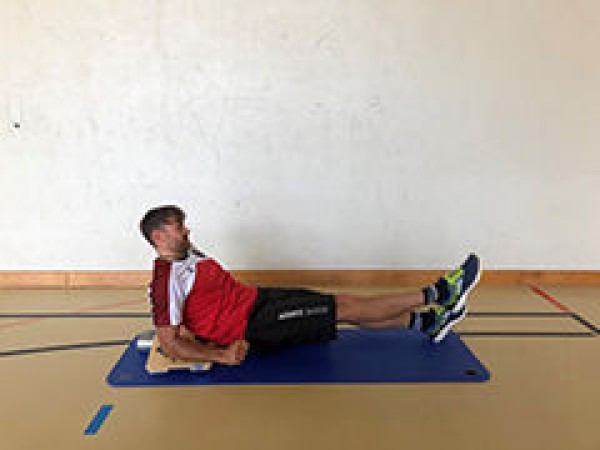
Inverted forearm support (the outstretched legs and upper body practically form a line, the legs are supported on the heels and the upper body on the forearms, the face/gaze thus points upwards, the forearms lie parallel to each other flat on the balance board, the upper arms are vertical), alternately raise one leg outstretched (approximately at the height of the tip of the foot) and lower it again.
Attention:
Enormously difficult exercise.
Head, torso, hips and knees practically form a line (do not let your buttocks sag, tense your stomach), do not hyperextend your knee joints.
Lighten:
Without a balance board; bend your legs slightly; use a balance board for your legs, as it may be too difficult for your arms.
Harden:
Additional weight (on your hips/legs)
1 balance board
1 weight vest/weight disc/sandbag/2 weight cuffs ► Make the exercise more difficult (additional weight)
Raising and lowering one leg alternately in a push-up position
Power
Individual work
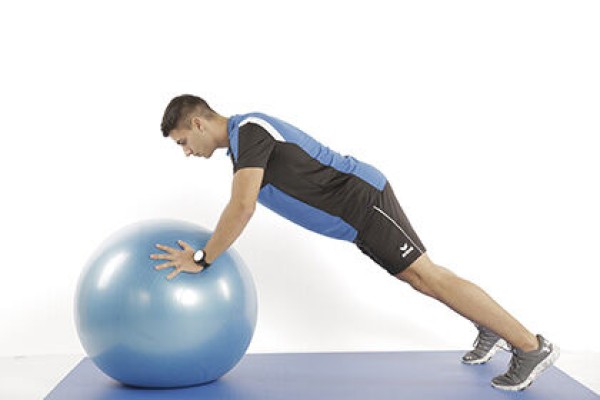
Push-up position, hands placed on the exercise ball, legs (and arms) stretched, alternately lift one leg slightly and return to the starting position.
Attention:
No hollow back, head in extension of the spine, shoulders remain above the elbows. To prevent the ball from rolling away, you can lean it against a wall.
Lighten:
Support yourself in place (without lifting and lowering your legs).
Harden:
Additional weight (on your back).
1 exercise ball
1 weight vest/weight disc/sandbag ► Make the exercise more difficult (additional weight)
Raising and lowering one leg alternately in a push-up position
Power
Individual work
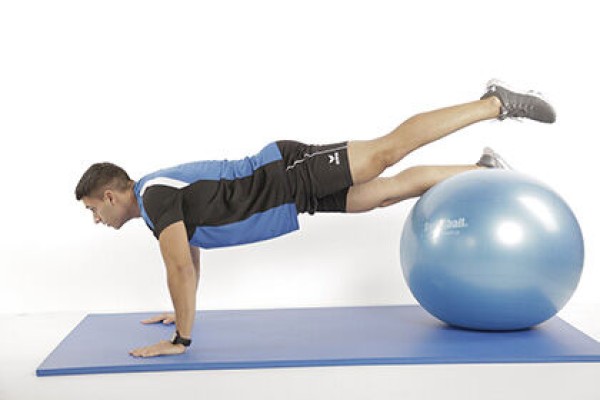
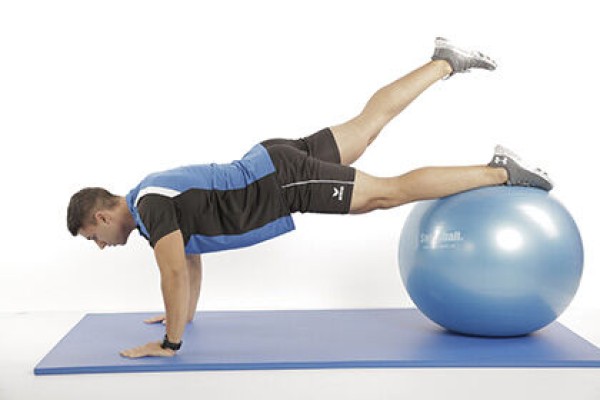
Push-up position, legs (shins) placed on the exercise ball, alternately lift one leg slightly and return to the starting position.
Attention:
Head, shoulders, buttocks and feet form a line, no hollow back, actively tense the torso. To prevent the ball from rolling away, you can lean it against a wall.
Lighten:
Support yourself in place (without lifting and lowering your legs); exercise ball closer to your hips.
Harden:
Additional weight (on your back); unstable support for your arms.
1 exercise ball
1 weight vest/weight disc/sandbag ► to make the exercise more difficult (additional weight)
1 balance cushion/balance board/2 wedges ► to make the exercise more difficult (unstable base)
Raising and lowering one leg in a push-up position alternately
Power
Individual work
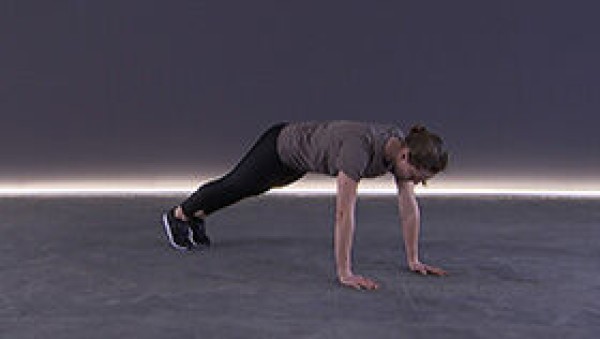
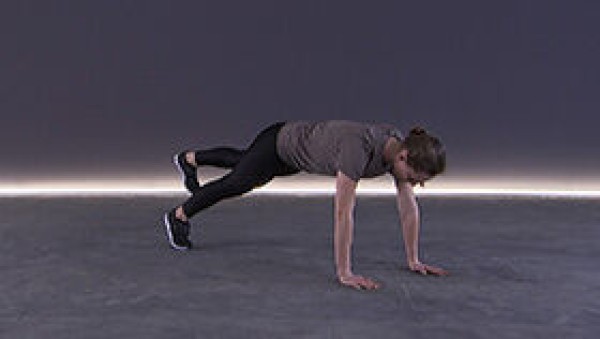

Push-up position (high support, face/look down), alternately raise and lower one leg.
Attention:
Keep your upper body stable, no hollow back (tighten your stomach).
Lighten:
Just hold the basic position (push-up position); lift your legs less off the floor.
Harden:
Additional weight (on the legs and/or on the back); unstable support for the arms.
Variant:
Underarm support (instead of push-up position).
2 weight cuffs/1 weight vest/weight disc/sandbag ► making the exercise more difficult (additional weight)
1 balance cushion/balance board ► making the exercise more difficult (unstable surface)
Raising and lowering one leg alternately in a push-up position
Power
Individual work
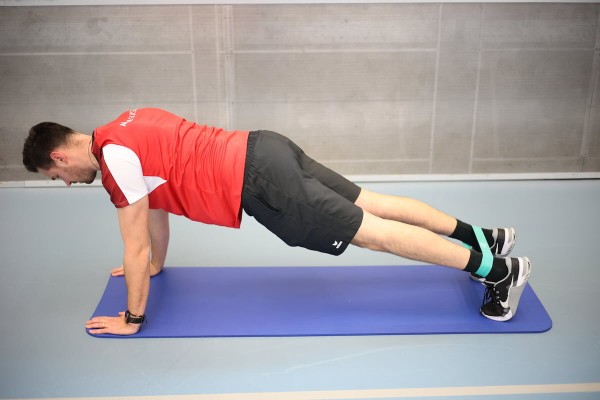
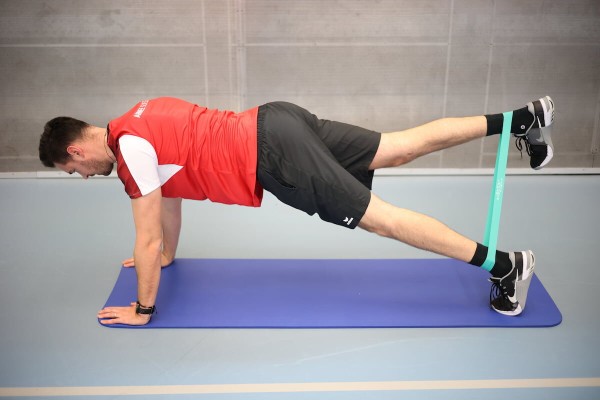
Push-up position (high plank, face/look down), stretch an elasticated band between your legs (place the band around your ankles), alternately raise and lower one leg (alternating hip extension).
Attention:
Keep your upper body stable, no hollow back (tighten your stomach).
Lighten:
Choose a rubber band with less resistance.
Harden:
Choose a rubber band with greater resistance; additional weight (on the legs and/or back); unstable support for the arms.
Variant:
Underarm support (instead of push-up position).
1 mini band
2 weight cuffs/1 weight vest/weight disc/sandbag ► to make the exercise more difficult (additional weight)
1 balance cushion/balance board ► to make the exercise more difficult (unstable base)
Raising and lowering one leg in supine position (left) ► one leg raise
Power
Individual work
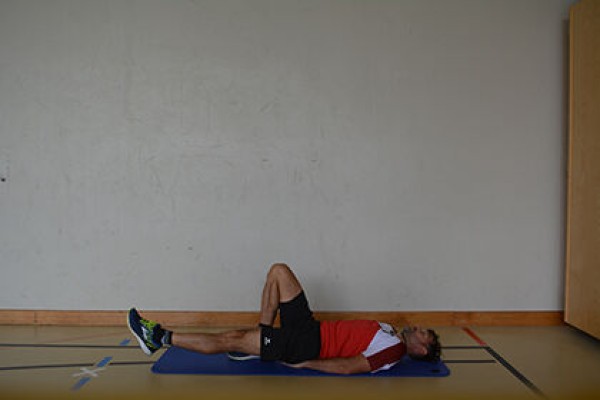

Lie on your back, one leg stretched out slightly off the floor (left), the other leg (right) lying flat on the floor or bent with the foot flat on the floor. Place your arms flat on the floor at your sides or place your hands under your buttocks. Raise the slightly raised leg as straight as possible upwards and back to the starting position. The greater the flexibility, the more vertically the leg can be raised to the holding position.
Attention:
Keep your (lower) back in constant contact with the floor (no hollow back, consciously tense your stomach), do not put your leg down.
Lighten:
Just hold the position (leg extended slightly off the floor); lower the leg completely after each exercise.
Harden:
Additional weight for the leg.
Variant I:
Execute circular movements with the free leg or spread the leg out and bring it back to the centre.
1 weight cuff ► Make the exercise more difficult (additional weight)
Raising and lowering one leg in supine position (right) ► one leg raise
Power
Individual work

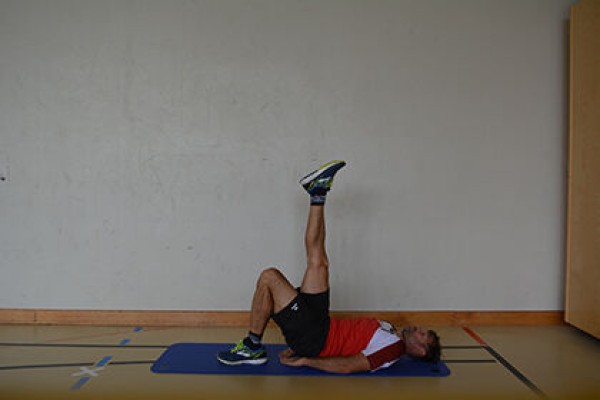
Lie on your back, one leg stretched out slightly off the floor (right), the other leg (left) lying flat on the floor or bent with the foot flat on the floor. Place your arms flat on the floor at your sides or place your hands under your buttocks. Raise the slightly raised leg as straight as possible upwards and back to the starting position. The greater the flexibility, the more vertically the leg can be raised to the holding position.
Attention:
Keep your (lower) back in constant contact with the floor (no hollow back, consciously tense your stomach), do not put your leg down.
Lighten:
Just hold the position (leg extended slightly off the floor); lower the leg completely after each exercise.
Harden:
Additional weight for the leg.
Variant I:
Execute circular movements with the free leg or spread the leg out and bring it back to the centre.
1 weight cuff ► Make the exercise more difficult (additional weight)
Raising and lowering one leg in supine position alternately ► one leg raise / lying scissor raise / lying single leg raise
Power
Individual work
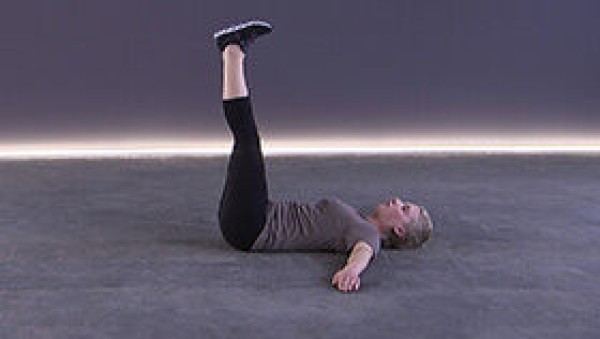
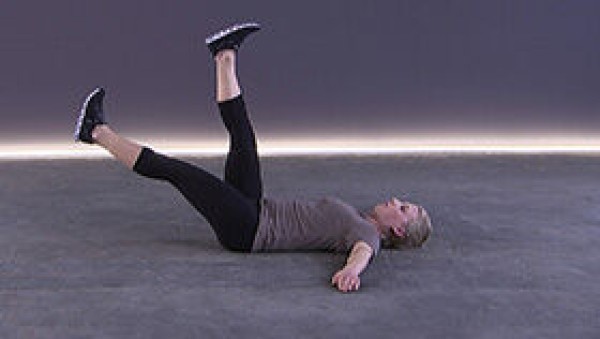
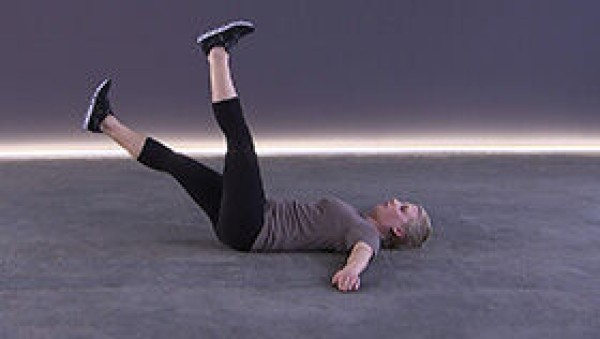
Lie on your back, legs stretched and slightly raised, arms at your sides on the floor, legs crossed alternately (scissor movement).
Attention:
Keep your back in constant contact with the floor (no hollow back, consciously tense your stomach), do not put your legs down.
Lighten:
Spread your legs less; keep your legs slightly higher; just hold the position.
Harden:
Add weight to your legs.
Variant I:
Move your legs up and down instead of sideways (lift and lower slightly).
Variant II:
Make circular movements with your legs.
2 weight cuffs ► Make the exercise more difficult (additional weight)
Raising and lowering an object while standing ► hammer slam
Power
Individual work
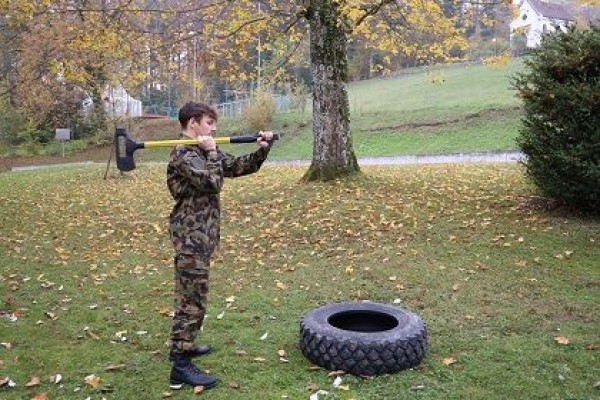
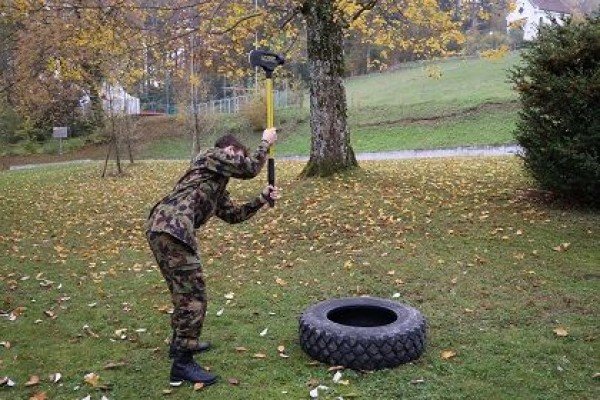
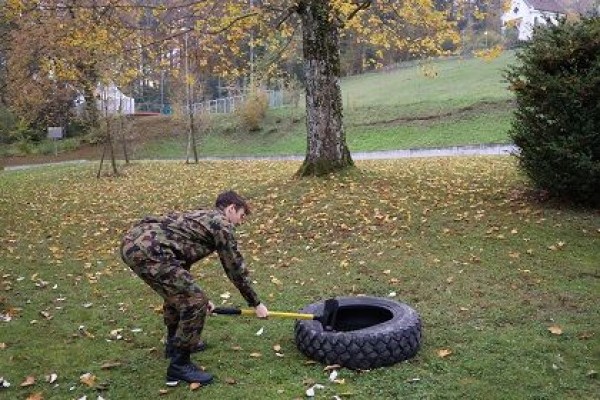
Grab the sledgehammer with both hands and strike the tyre lying on the ground (start the lunging motion behind your back).
Attention:
Brake the hammer on the tyre and do not let it bounce.
Lighten:
Lower cadence/impact intensity.
Harden:
Higher cadence/impact intensity.
1 tyre (10DM)
1 sledgehammer
Raising and lowering an object while standing ► wrist curl
Power
Individual work
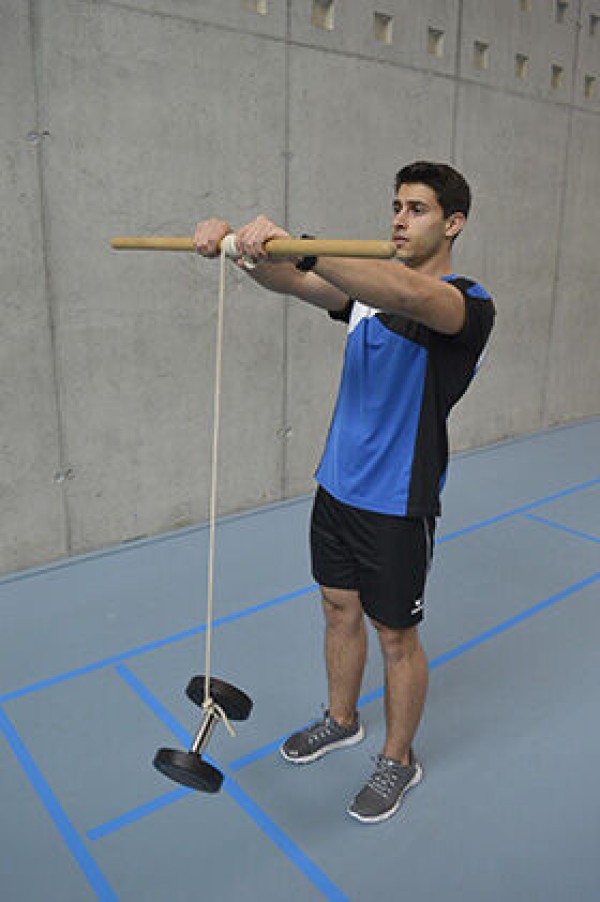
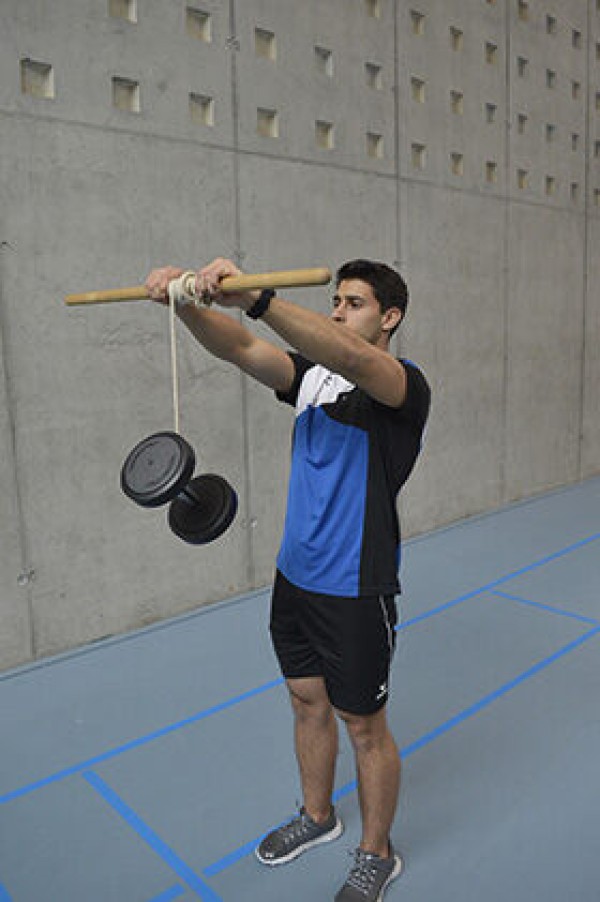
Stand upright, arms (almost) shoulder-width apart in front of you (chest height), hold a pole in your hands (overhand grip), attach a weight to the pole with a cord/rope, roll up the cord/rope by turning the pole and roll it back to the starting position in a controlled/slow manner (lift and lower the weight).
Lighten:
Less weight.
Harden:
More weight.
Variant I:
Arms bent.
Variant II:
Arms bent and elbows resting on a swinging box.
1 gymnastics pole/wooden stick
1 weight disc/dumbbell
Cord or rope to attach the object to the pole
1 vaulting box ► Variation of the exercise
Raising and lowering as well as extension and flexion of one arm crosswise in supine position alternating (trunk bend) ► rotational sit up / sitting punches / boxing crunch
Power
Individual work
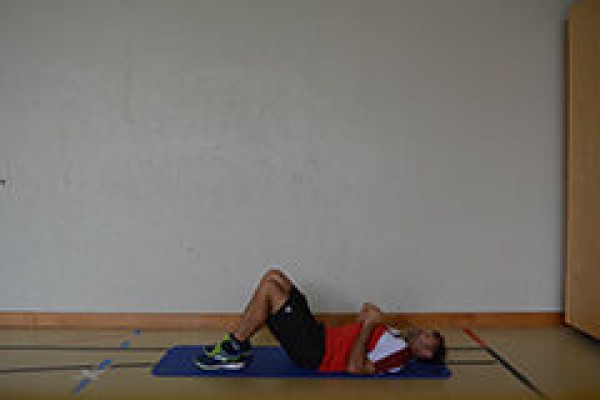
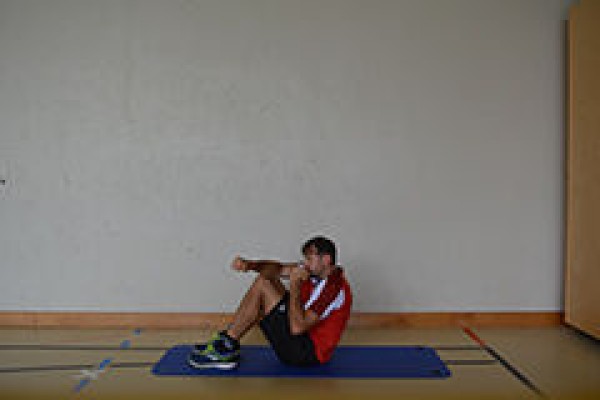
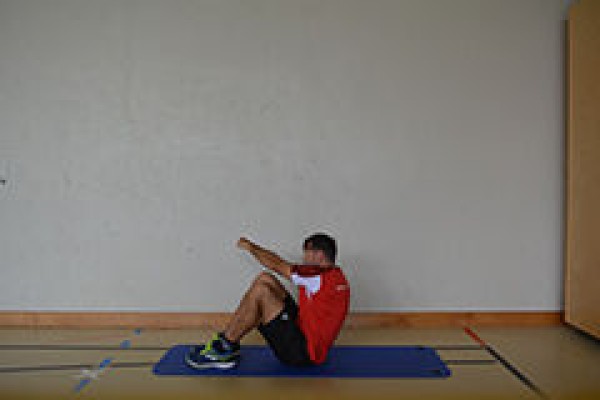
Lie on your back with your legs bent (feet also bent or flat on the floor), arms also bent and resting against your body (upper arms flat on the floor, forearms pointing upwards, both hands clenched into fists). Straighten the upper body and at the same time extend one arm crosswise past the knee to the side (strike a straight line). When the upper body is lowered back to the starting position, bend the punching arm again. As you raise your upper body again, change the side of the punching arm.
Attention:
Do not lower your upper body completely (constant tension).
Lighten:
Bend your legs less (almost stretched); work more with momentum.
Harden:
Hold additional weight in your hands.
2 weight cuffs/weight balls/dumbbells ► Make the exercise more difficult (additional weight)
Raising and lowering as well as extension and flexion of one arm crosswise in supine position alternating (trunk bend) ► rotational sit up / sitting punches / boxing crunch
Power
Individual work
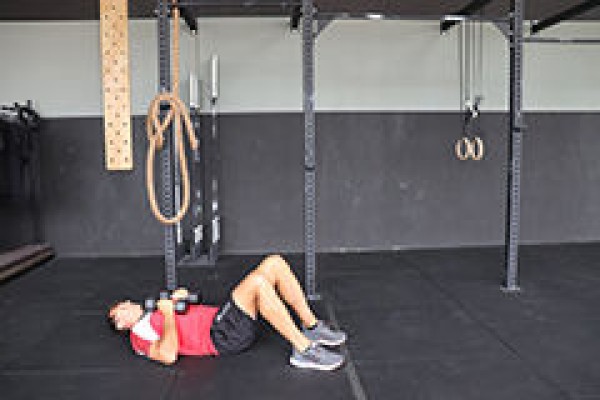
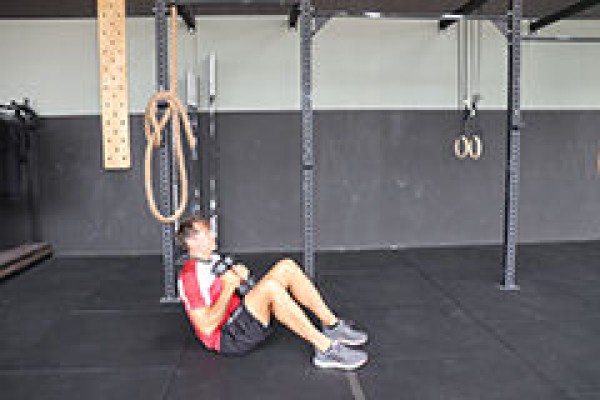
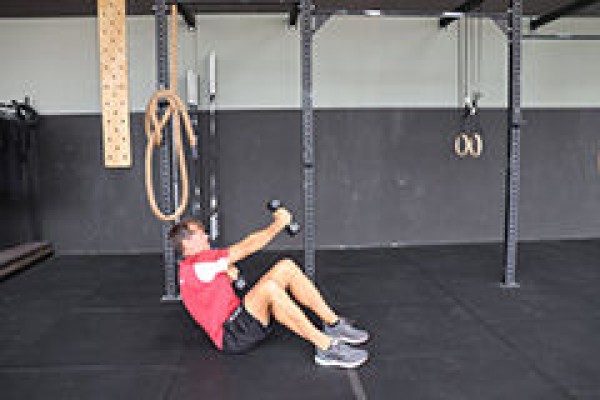
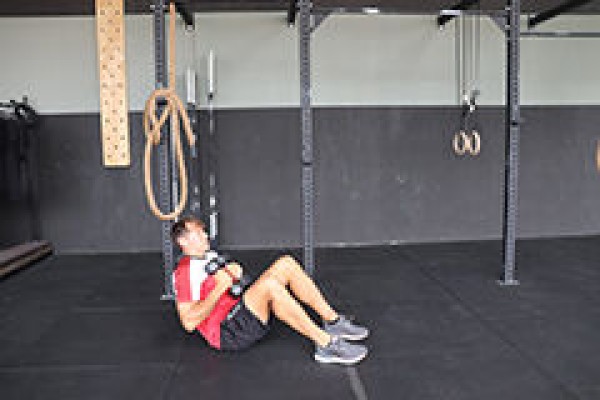
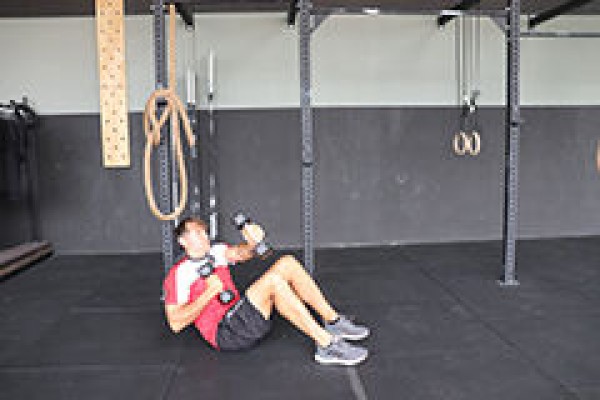

Lie on your back with your legs bent (feet also bent or flat on the floor - possibly even clamped for more stability/hold), grasp a dumbbell with both hands, hold the weight in front of your chest with your arms bent (upper arms flat on the floor against your body, forearms pointing horizontally upwards - approx. 90 degree angle at the elbow joint). Raise your upper body, alternately stretch one arm diagonally across the front and back to the starting position (two straight punches - one to the left, one to the right). After the two punches, lower your upper body back to the supine position.
Attention:
Upper body/gaze accompanies the punching movement (body turned out to the side). Keep your head in a neutral position.
Lighten:
Less or no weight; legs/feet fixed.
Harden:
More weight.
2 dumbbells
Raising and lowering as well as rotation of the upper body in push-up position ► push up & rotation
Power
Individual work
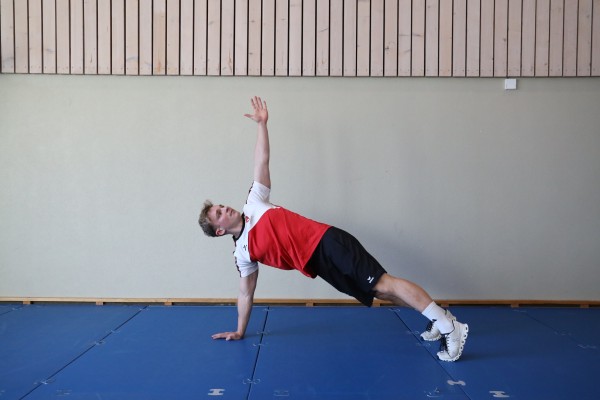
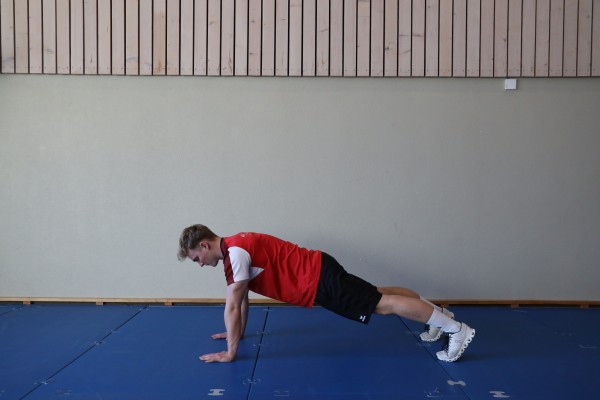
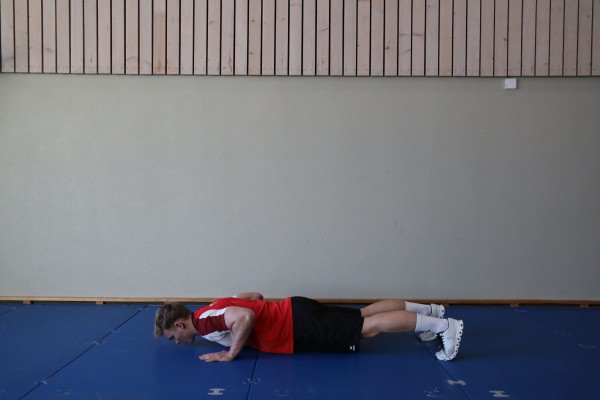

In the push-up position, bend and stretch your arms (lower and raise your upper body). Back in the starting position, raise one arm vertically upwards in an arching movement, turning your body sideways, your gaze following the outstretched arm. Switch sides for the next exercise.
Attention:
In push-up position: head, torso, hips and knees practically form a line (do not stretch your buttocks upwards or let them sag, tense your stomach). Push-ups: no hollow back and elbows bent at an angle of approx. 45° from the upper body ("A" shape with the arms). The shoulders are fixed and pulled down towards the hips.
Lighten:
Support your knees on the floor (feet held high). Without push-ups; alternately rotate upper body in push-up position.
Harden:
Additional weight: support both hands on a dumbbell in the push-up position.
2 dumbbells ► make the exercise more difficult (additional weight)
Raising and lowering as well as rotation of the upper body in supine position (trunk bend) (left) ► cross crunch
Power
Individual work
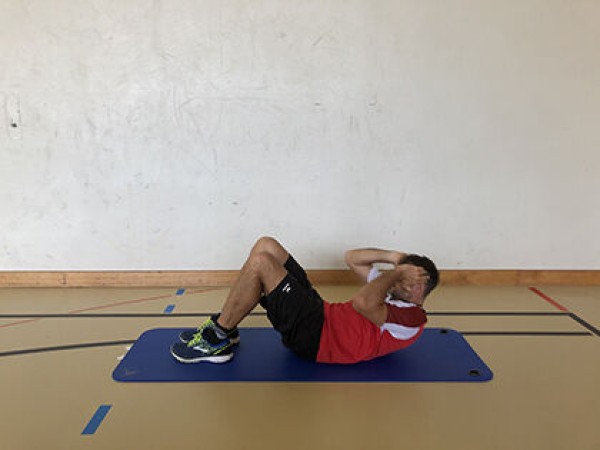

Lie on your back with your legs bent (feet also bent or flat on the floor), arms bent so that each hand is placed next to the nearest ear. Raise and rotate the upper body to move the elbow (left) crosswise to the knee (right). Lower your upper body and return to the starting position.
Attention:
Do not lower your upper body completely (constant tension), do not pull on your head with your hands (really keep your hand next to your ear).
Lighten:
Lift your upper body less; cross your arms over your chest.
Harden:
Stretch your arms above your head (holding them up) and move your hand (possibly even with additional weight) crosswise to your knee (work without momentum).
1 weight cuff/weight ball/weight disc (small)/dumbbell ► Make the exercise more difficult (additional weight)
Raising and lowering as well as rotation of the upper body in supine position (trunk bend) (right) ► cross crunch
Power
Individual work
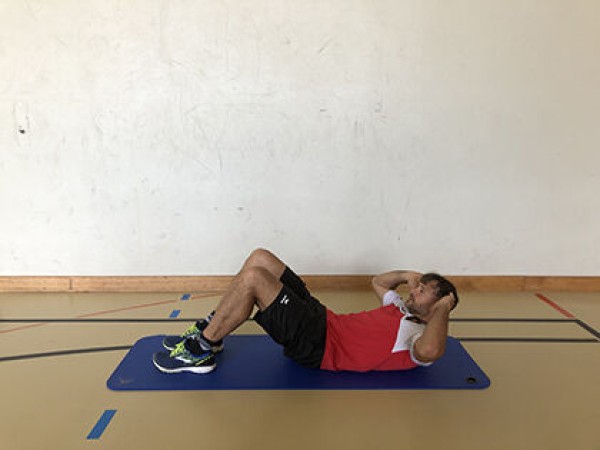
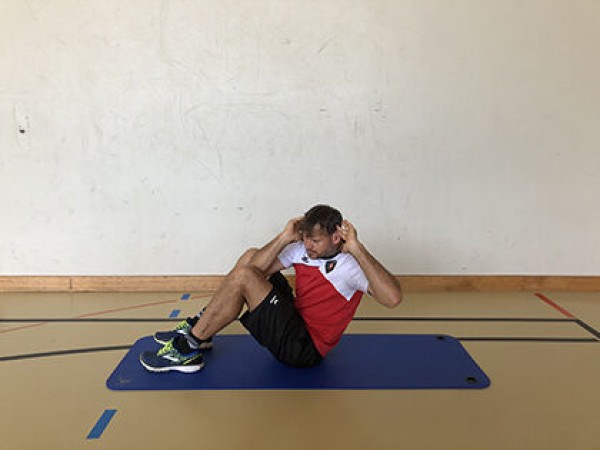
Lie on your back with your legs bent (feet also bent or flat on the floor), arms bent so that each hand is placed next to the nearest ear. Raise and rotate the upper body to move the elbow (right) crosswise to the knee (left). Lower your upper body and return to the starting position.
Attention:
Do not lower your upper body completely (constant tension), do not pull on your head with your hands (really keep your hand next to your ear).
Lighten:
Lift your upper body less; cross your arms over your chest.
Harden:
Stretch your arms above your head (holding them up) and move your hand (possibly even with additional weight) crosswise to your knee (work without momentum).
1 weight cuff/weight ball/weight disc (small)/dumbbell ► Make the exercise more difficult (additional weight)
Lifting and lowering as well as rotating the upper body in supine position alternately (trunk bend) ► cross crunch
Power
Individual work
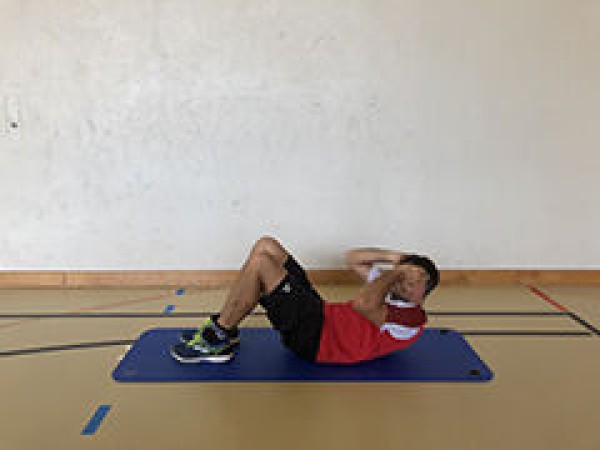
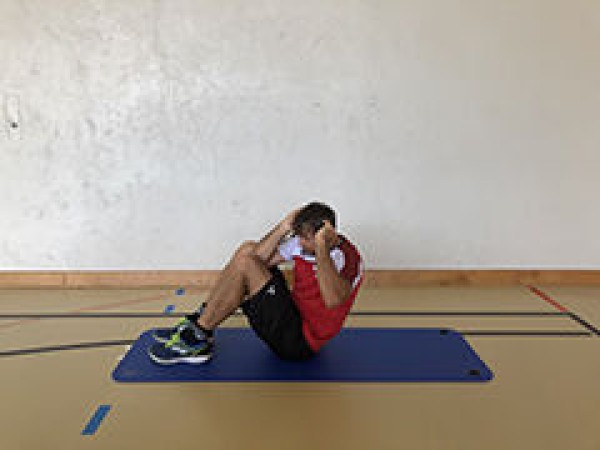

Lie on your back with your legs bent (feet also bent or flat on the floor), arms bent so that each hand is placed next to the nearest ear. Raise and rotate the upper body to move the elbow crosswise to the knee. Lower your upper body and return to the starting position. Switch sides with each repetition.
Attention:
Do not lower your upper body completely (constant tension), do not pull your head with your hands (really keep your hand next to your ear).
Lighten:
Lift your upper body less; cross your arms over your chest.
Harden:
Stretch your arms above your head (holding them up) and move your hand (possibly even with additional weight) crosswise to your knee (work without momentum).
2 weight cuffs/weight balls/weight discs (small)/dumbbells ► Make the exercise more difficult (additional weight)
Lifting and lowering as well as rotating the upper body in supine position alternately (trunk bend) ► cross crunch
Power
Individual work
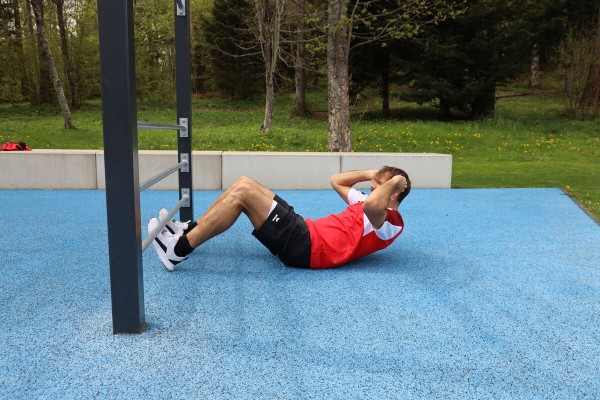
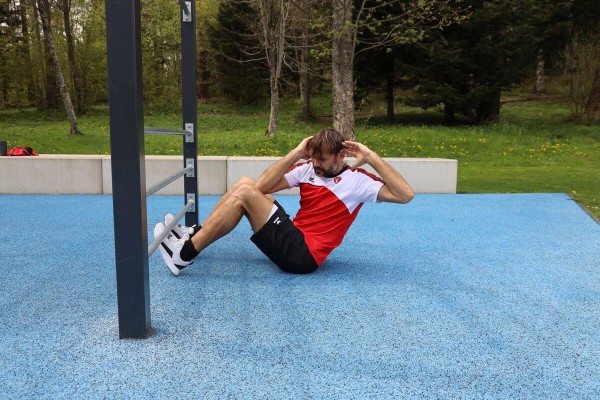
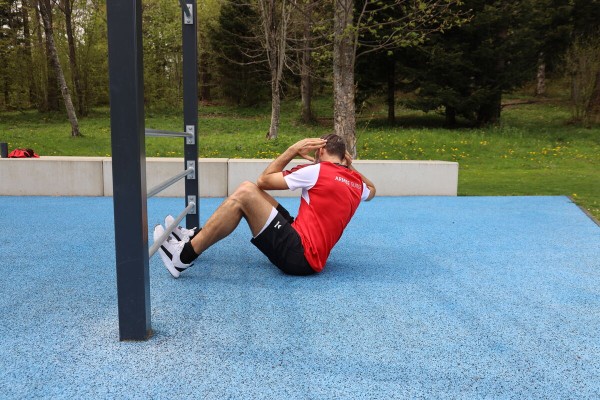
Lie on your back with your legs bent and your feet hooked onto the (very low) horizontal bar (or wall bars) (instep on the bar/bar), arms bent so that each hand is placed next to the nearest ear. Raise and rotate the upper body to move the elbow crosswise to the knee. Lower your upper body and return to the starting position. Switch sides with each repetition.
Attention:
Do not lower your upper body completely (constant tension), do not pull your head with your hands (really keep your hand next to your ear).
Lighten:
Lift your upper body less; cross your arms over your chest.
Harden:
Stretch your arms above your head (holding them up) and move your hand (possibly even with additional weight) crosswise to your knee (work without momentum).
2 weight cuffs/weight balls/weight discs (small)/dumbbells ► Make the exercise more difficult (additional weight)